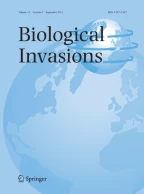5009Accesses
188Citations
16 Altmetric
1Mention
AnErratum to this article was published on 11 July 2006
Abstract
Freshwater aquatic organisms in North America are disproportionately imperilled when compared to their terrestrial counterparts due to widespread habitat alteration, pollution, overexploitation and the introduction of alien species. In this review, we examine the threat factors contributing to the endangerment of freshwater fishes and molluscs in Canada and further examine the nature of alien invasive species introductions affecting aquatic species at risk. Habitat loss and degradation is the predominant threat factor for Canadian freshwater fishes and molluscs that are listed as Extinct, Extirpated, Endangeredand Threatened. Alien invasive species are the second most prevalent threat for fishes, affecting 26 of 41 listed species. Alien invasive species are a threat in most parts of Canada where listed fishes are found. Most (65%) of the alien invasive species affecting listed fishes are the result of intentional introductions related to sport fishing, and the majority of these introductions are unauthorized. Fifteen fishes and two plant species are cited as alien invasive species that impact listed fishes with brown bullhead (Ameiurus nebulosus) and pumpkinseed (Lepomis gibbosus) being the most prevalent. Alien species are a threat to 6 of 11 listed mollusc species. All six species are threatened by the alien zebra mussel (Dreissena polymorpha) in the Great Lakes basin.
This is a preview of subscription content,log in via an institution to check access.
Access this article
Subscribe and save
- Starting from 10 chapters or articles per month
- Access and download chapters and articles from more than 300k books and 2,500 journals
- Cancel anytime
Buy Now
Price includes VAT (Japan)
Instant access to the full article PDF.
Similar content being viewed by others
Explore related subjects
Discover the latest articles, books and news in related subjects, suggested using machine learning.References
DM Baltz PB Moyle (1993)ArticleTitleInvasion resistance to introduced species by a native assemblage of California stream fishesEcological Applications2 246–255OccurrenceHandle10.2307/1941827
C Chu CK Minns NE Mandrak (2003)ArticleTitleComparative regional assessment of factors impacting freshwater fish biodiversity in CanadaCanadian Journal of Fisheries and Aquatic Sciences60 624–634OccurrenceHandle10.1139/f03-048
AH Clarke (1981) The Freshwater Molluscs of Canada. National Museums of Canada Ottawa 466
InstitutionalAuthorNameCOSEWIC (2003) Canadian Species at Risk, November 2003 Committee on the Status of Endangered Wildlife in Canada Ottawa 44
Emery L (1985) Review of Fish Species Introduced into theGreat Lakes, 1819–1974. Great Lakes Fisheries Commission Technical Report Number 45, 31 pp
DO Evans DH Loftus (1987)ArticleTitleColonization of inland lakes in the Great Lakes region by rainbow smelt,Osmerus mordax: their freshwater niche and effects on indigenous fishesCanadian Journal of Fisheries and Aquatic Sciences44IssueIDSuppl 2 249–266
WG Franzin BA Barton RA Remnant DB Wain SJ Pagel (1994)ArticleTitleRange extension, present and potential distribution,and possible effects of rainbow smelt in Hudson Bay drainage waters of northwestern Ontario, Manitoba, and MinnesotaNorth American Journal of Fisheries Management14 65–76OccurrenceHandle10.1577/1548-8675(1994)014<0065:REPAPD>2.3.CO;2
T Hatfield (2001)ArticleTitleStatus of the stickleback species pair, Gasterosteus spp., in Hadley Lake, Lasqueti Island, British ColumbiaCanadian Field-Naturalist115 579–583
InstitutionalAuthorNameIUCN (2002) IUCN Red List of Threatened Species The World Conservation Union, Gland Switzerland
DR Lassuy (1995)ArticleTitleIntroduced species as a factor in extinction and endangerment of native fish speciesAmerican Fisheries Society Symposium15 391–396
Mandrak NE (2003) Proposed National Freshwater EcologicalAreas Classification for COSEWIC. Prepared on behalf of the Freshwater Fishes Subcommittee by Nicholas E. Mandrak, November 2002 (revised April 2003), 7 pp
RR Miller JD Williams JE Williams (1989)ArticleTitleExtinctions of North American fishes during the past centuryFisheries14IssueID6 22–38OccurrenceHandle10.1577/1548-8446(1989)014<0022:EONAFD>2.0.CO;2
EL Mills JH Leach JT Carlton CL Secor (1993)ArticleTitleExotic species in the Great Lakes: a history of bioitic crises and anthropogenic introductionsJournal of Great Lakes Research19 1–54OccurrenceHandle10.1016/S0380-1330(93)71197-1
SL Pimm JB Hyman (1987)ArticleTitleEcological stability in the context of multispecies fisheriesCanadian Journal of Fisheries and Aquatic Sciences44IssueIDSupplement 2 84–94
A Ricciardi H MacIsaac (2000)ArticleTitleRecent mass invasion of the North American Great Lakes by Ponto-Caspian speciesTrends in Ecology and Evolution15 62–65OccurrenceHandle10652557OccurrenceHandle10.1016/S0169-5347(99)01745-0
A Ricciardi JB Rasmussen (1999)ArticleTitleExtinction rates of North American freshwater faunaConservation Biology13 1220–1222OccurrenceHandle10.1046/j.1523-1739.1999.98380.x
A Ricciardi RJ Neves JB Rasmussen (1998)ArticleTitleImpending extinctions of North American freshwater mussels (Unioinida) following the zebra mussel (Dreissena polymorpha) invasionJournal of Animal Ecology67 613–619OccurrenceHandle10.1046/j.1365-2656.1998.00220.x
DW Schloesser TF Nalepa GL Mackie (1996)ArticleTitleInfestation of unioinid bivalves (Unioinidae) by zebra mussels,Dreissena polymorpha, in North America to 1994.American Zoologist36 300–310
JN Taylor WR CourtenaySuffixJr JA McCann (1984) Known impacts of exotic fishes in the continental Unites States WR CourtenaySuffixJr JR StaufferSuffixJr (Eds) Distribution, Biology, and Management of Exotic Fishes John Hopkins University Press Baltimore, MD 322–373
ML WarrenSuffixJr BM Burr (1994)ArticleTitleStatus of freshwater fishes of the United States: overview of an imperilled faunaFisheries19IssueID1 6–18OccurrenceHandle10.1577/1548-8446(1994)019<0006:SOFFOT>2.0.CO;2
JD Williams ML WarrenSuffixJr KS Cummings JL Harris RJ Neves (1993)ArticleTitleConservation status of freshwater mussels of the United States and CanadaFisheries18IssueID9 6–22OccurrenceHandle10.1577/1548-8446(1993)018<0006:CSOFMO>2.0.CO;2
D Wright (2002) Intentional introductions of alien species of fish: have we learned from our mistakes R Claudi P Nantel E Muckle-Jeffs (Eds) Alien Invaders in Canada’s Waters, Wetlands, and Forests, pp 201–217 Canadian Forest Service, Natural Resources Canada Ottawa
Author information
Authors and Affiliations
Species at Risk Section, Ontario Ministry of Natural Resources, Box 7000, Peterborough, Ontario, K9J 8M5, Canada
Alan J. Dextrase
Great Lakes Laboratory for Fisheries and Aquatic Sciences, Fisheries and Oceans Canada, 867 Lakeshore Road, Burlington, Ontario, L7R 4A6, Canada
Nicholas E. Mandrak
- Alan J. Dextrase
Search author on:PubMed Google Scholar
- Nicholas E. Mandrak
Search author on:PubMed Google Scholar
Corresponding author
Correspondence toAlan J. Dextrase.
Additional information
An erratum to this article is available athttp://dx.doi.org/10.1007/s10530-006-1833-0.
Rights and permissions
About this article
Cite this article
Dextrase, A.J., Mandrak, N.E. Impacts of Alien Invasive Species on Freshwater Fauna at Risk in Canada.Biol Invasions8, 13–24 (2006). https://doi.org/10.1007/s10530-005-0232-2
Received:
Accepted:
Issue date:
Share this article
Anyone you share the following link with will be able to read this content:
Sorry, a shareable link is not currently available for this article.
Provided by the Springer Nature SharedIt content-sharing initiative


